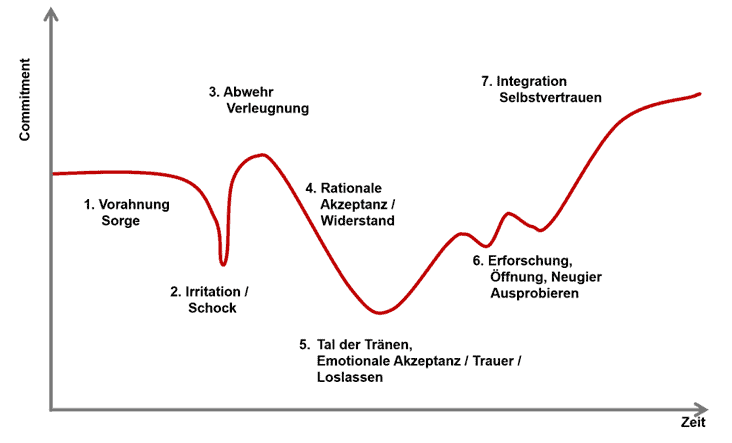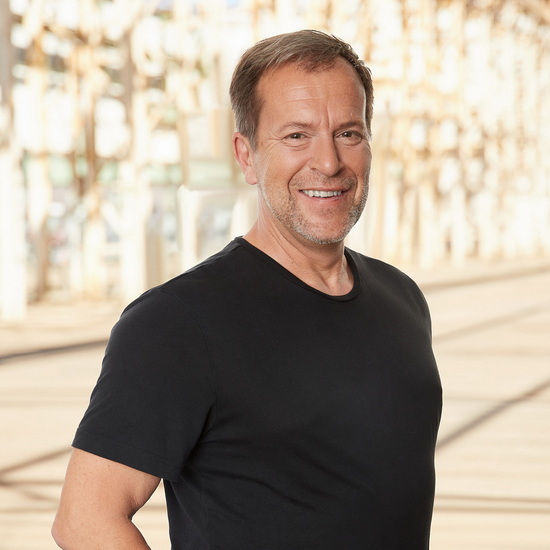Change versus transformation: the difference
Change or transformation – what’s behind it?
Change and transformation – these are two words that we hear again and again in the business context. Sure, it’s about changes in organizations or societies. So far so good. But do you know what exactly the difference is between change and transformation? The terms sound similar, but there are fundamental differences that are worth taking a closer look at: both transformation and change can help you tackle challenges in your company. In this article, we explain what is helpful in which situation and what is not.
Change is necessary, but how?
RainGod is a company that manufactures outdoor clothing and equipment. The company is currently facing some difficulties: recently there was a TV report about the environmental impact of a raw material used in some weather jackets. This is not only problematic for the environment; RainGod’s nature-loving customers rightly want to do without this conscious raw material. Since the report, complaint e-mails have been flooding mail accounts. In addition, a Chinese provider is currently flooding social media with tempting cheap offers in the outdoor sector and seems to be doing pretty good business. And then there are a few open positions in the company that nobody wants to queue up for. Solutions need to be found for all of this.
The family-run company has a wide variety of people working together and the atmosphere is good. Family members discuss the situation.
Change and transformation – different approaches
Frank, an experienced manager, 54, is a big fan of traditional change management. He sees changes as planned conversions in which clear goals are pursued and everything is structured and controlled: like the construction of a new building; a fixed plan that is followed from start to finish. He likes to see himself in the role of change architect, although his sober approach is more akin to that of an engineer. Frank has a coffee cup labeled “Change Expert”. Every time there have been changes in the company so far, Frank has been the first to draw up plans and explain to the others how they should adapt.
Cleo, 27, is the exact opposite of Frank. She is of the opinion that you should not wait for problems before solving them. “What do you think? – It’s obvious that this will happen sooner or later” is one of the sentences you often hear from her. She doesn’t make any friends at that moment, but everyone realizes that she is ultimately right. She believes that RainGod should change profoundly: “It needs a different world view, a different Corporate culture. Then we can also deal with the problems that are waiting for us around the next corner.” She paws a little. She finds it exciting to develop completely new, creative approaches.
Tessa, 37, is a little more reserved than her colleagues. Tessa is open to change, but also skeptical if it is too fast and too radical. She believes that changes should be carefully planned and implemented together with the employees. Communication and participation are important to Tessa to ensure that everyone involved can make their voice heard.

Change
What is change?
Change is a process of change that aims to achieve a previously defined goal. A change is an event with a beginning and an end and goes through phases such as planning, implementation, control and troubleshooting.
What is change management?
Change management means the structured and controlled support of change processes in organizations.
Changes in companies are first planned with the help of change management and then implemented according to plan. To ensure that the change measures are successful, they are implemented in a targeted and controlled manner until the desired state is achieved.
Even more detailed? Then read our article on Change Manager Definition & Tips: How to lead change successfully!
Why change management?
Change management is a pragmatic way of increasing a company’s performance: structures and processes are optimized to ensure maximum efficiency and effectiveness.

Who shapes change management?
In practice, there are often only a few insiders who have an insight into the strategy, time frame or subsequent measures. The insiders plan, budget, schedule and inform. – The uninitiated are informed (in the best case) and can then contribute to the “How?”. They should adapt to what the so-called rollout brings. (Rollout: implementation of the measures).
How does change work?
How does a change process work? First, the desired state, the desired result is defined, then suitable steps to achieve it are combined into a plan. This is processed step by step and precisely; adherence to the plan and results are monitored and, if necessary, corrective measures are taken in the event of “disruptions”.
Just like a bus journey: the challenge is to get 30 people from A to B. The departure time is set, the costs are calculated, a route is determined and an arrival time is defined. At best, passengers are informed of the timetable. Taking people along” or “inviting them along” are the metaphors often used.

Change management – the solution for everything?
Frank starts: “The questionable raw material must be replaced!” His plan: What alternatives are there? Where can he get them? The whole thing needs to be publicized in a campaign.
The Chinese competition works on price, so a campaign is needed that emphasizes the traditional company and the quality made in Germany.
Frank’s tactic is to also cut the price.
“And then the job advertisements have to be written differently. Maybe publish them on Facebook too?” “Facebook? For real?” asks Cleo. “Well, even if you somehow find one… I’m just saying: traditional company!” Who wants that nowadays? We really need to turn things around. We could also develop completely new products, couldn’t we? In all the complaint emails, people have written what they want!”
“Yes, Cleo,” says Tessa, “we really should move with the times. And on several levels at once. But first we have to see what we can manage.”
Disadvantages of change and change management
In change management, people are often seen as variables. It is assumed that they can be influenced. However, the group dynamics of employees within the organization are often seen as almost impossible to control and are treated as a side effect of the change process. The needs of the employees become a minor matter, which hopefully does not cause too much trouble afterwards.
First, the change is implemented and the corresponding processes and structures are changed. Possible errors, disruptions and sensitivities are then rectified or repaired with the help of change management. This means that people are only looked at retrospectively, with the aim of ensuring that they adapt to the change.
Back to the bus example: the employees are supposed to board as passengers in something that the insiders have previously defined. The location of the stops, arrival and departure times, frequency of the buses, number of seats and price have already been determined. “Invite, take along and then overcome disruptions” – this is how the change logic can be described.

The change curve
The change curve: from change to adaptation
When everything is suddenly unfamiliar and different, it can be a real challenge for people! Employees first have to find a way of dealing with a change. This visualizes the change curve:
Inspired by Elisabeth Kübler-Ross’ grief curve, the change curve shows the different phases that we go through during a change process. From initial shock and rejection to acceptance and adaptation – each phase is part of the change. Change management aims to guide people through this curve and prepare them for the new situation.

Tips for dealing with change
To help you support your employees in times of change, here are a few tips based on the phases of the change curve.
-
Clear, unambiguous communication:
In phases 1 and 2, you should be as open and honest as possible. Anything else fuels rumors and worries. If you do not yet have more information, communicate that too, or when employees can expect to receive information
-
Transparency:
Give your colleagues the full information! It is important to say the “whole picture” and not to use “salami tactics”, even if it hurts. Open communication creates trust, even if the message itself is unpleasant.
-
Dealing with resistance in phase 4:
Resistance is uncomfortable. But if you suppress it, it will only get stronger. It is important to allow resistance, actively initiate constructive criticism and offer a platform for this. Understand resistance as helpful information in the change process!

-
Give employees time to accept:
Understand that your colleagues have not yet gone as far through the curve as you have. Express this too, listen and signal emotional involvement. However, when it comes to issues that cannot be changed, remain clear and don’t fiddle around.
-
Enable trial and error in phase 6:
Let people try out how the new works. Here you should ensure that mistakes are dealt with constructively, encourage the implementation of new ideas and create forums for sharing and learning.
-
Involve and encourage those willing to change:
Not everyone will negotiate the bend at the same speed. There will be pioneers and people who find change difficult. Focus on those who want change. Involve them in finding solutions, create pleasant experiences for the early birds so that the organization feels that it was worth participating.
-
Communicate and celebrate successes:
The first positive effects can be spread quickly. People take courage when they realize that others are already on their way. Market your change, then even the hesitators and procrastinators will get on board.
When are the change tips helpful?
- If you want to steer a change by means of change.
- In a change process, it is the insiders who have to develop something and win the enthusiasm of the workforce. Understanding the emotions that a change can trigger will help you.
- For less important topics.
- When an event suddenly occurs (disasters): From the employees’ point of view, something happens that can hardly be influenced; they are affected – not involved or even shaping.
When change no longer helps: then transformation?
Tessa and Cleo agree to Frank’s plan to take a pragmatic approach to the raw materials problem. The shit has hit the fan and something has to be done immediately. The faster and more reliable the better. A case for Frank’s outstanding change management.
Frank has a feeling that Cleo is not entirely wrong with her profound desire for change and modernization. He is well aware that times, technology, customers and their demands have changed. And the Chinese competitor may not be the only one…
Frank: “Yes Cleo, but what specifically do you want to do differently and why?” Tessa gets involved and names many areas that need attention: the competitive situation, the shortage of skilled workers, the change in customer requirements, the changing demands of Generation Z on their employers and so on.
Cleo: “I don’t think we should just change one or two things and then carry on as before. When one trouble is gone, the next one starts. It’s always like that.” Tessa and Frank nod, embarrassed. How they could tackle such a transformation is beyond them. You call us.

Transformation
What is transformation?
A transformation in the corporate context is a far-reaching process of change without a clearly defined goal in order to realign the company. The company may have to change its business model and reposition itself, which can of course have an impact on the services and products it offers. The organization is thus repositioning itself for future challenges.
Transforming the company requires a rethink, a cultural change.
Employees help to shape this process; it is not simply something that happens that they have to cope with more or less well.
Transformation is a matter of getting down to business: culture, values, identity.
It is comparable to the growth process of a plant over the seasons. Every step leads to something new. A nut becomes a sprout becomes a sapling, becomes a tree. This is not a sudden event, but a constant change.

Transformation and change: the differences in a nutshell
Transformation is fundamentally different from change:
- A change is about making a few defined changes; a transformation is about a fundamental change, a paradigm shift.
- Transformation is a continuous process, not an event that needs to be dealt with afterwards.
- In order to transform a company, old convictions and ways of thinking have to be thrown out the window and values have to be questioned.
- Change is aimed at a fixed goal, transformations are open-ended.
- A change is often started with goals, then quickly moves on to the “What?” (must happen) in order to work on the “How?” later. A transformation progresses iteratively.
Company transformation: where to start?
Frank continues to make plans for general troubleshooting and smaller challenges. This also works extremely well.
RainGod wants to tackle the transformation to a modern company. The company has more or less been working away for the last few years. Some products performed very well. There has been no real realignment for a long time. There is uncertainty: can such a transformation also be a risk for the company? What will happen approximately? How should this work? What are we going to do now?
The seven phases of transformation
A transformation goes through various phases that typically occur in transformation processes:
-
Before the transformation: understanding the situation
The first step in a transformation is to find out what the direction of travel should be. Who knows this better than the people who know the market: employees, customers and suppliers. Ask these people! You first have to get to know what the situation really, really looks like before you can get started.
To initiate cultural change, we must first determine where RainGod stands. We send out a customer survey and back it up with qualitative interviews. This allows us to learn a great deal about how the company is viewed and where problems lie. Employees are also interviewed and this information is also processed. A “problem statement” is therefore drawn up before measures are discussed. A reason to act, a “why?” is therefore developed.
-
Cultural change: transformation and values
A successful transformation often requires a cultural change. This involves reviewing and adapting the values, beliefs and behaviors in the organization to support the desired changes.
Together with all employees at RainGod, we create a value profile with the ValueParty app from the berlin team. This shows the dominant values in the company, the special way of working together in the company and the priorities in action. We also identify the values that employees want and the values that are needed to be successful. It’s not surprising that Frank’s values are completely different from Cleo’s. The two of them have never thought about it in such detail.
Frank, for example, has his strongest values in the orange value cluster: he values goal-oriented action, performance, individual success and rewards. Cleo sees the world as networked, propagates self-management in teams and the learning organization. No wonder she has a strong swing in the yellow value system.You can get to know the ValueParty app here.
If you would like to delve a little deeper into the topics of values, value change and value management, we recommend our articles:
The Graves value system: what is really important to people
The Spiral Dynamics value model: What really matters to people 2/2
Why value management makes your company successful
Changing values: definition & guide to cultural change in your company -
Vision and direction of the transformation:
In this phase, a clear vision for the future direction of the organization is developed. It is about understanding where the journey should go and what should be achieved. The basic question here at the beginning is “Why?”, i.e. the “Why and what for?” (See also: Simon Sinek: “Start with Why?“)
Please note: This is not about concrete goals as in the case of a change, but about a broader vision based on what is really important.RainGod rounds up its employees. You work with ambassadors: one employee represents around 20 colleagues in this process. The challenges and results determined are put on the table. The team is happy to be involved. The workforce expresses observations, ideas, concerns and possible solutions. Together they define a vision that does justice to all those involved.
It emerges that the team’s main wish is for RainGod to become a dynamic, flexible and innovative company. You want to be able to react quickly to changes in the market. Structures should be open and be able to be adapted quickly. This should enable innovative product adaptations to be made quickly and close to the customer. -
Transformation planning phase:
In this phase, concrete plans are developed to realize the defined vision (not goal!). This happens at all levels and all employees are involved. Targets are set, resources are allocated and measures are taken to drive change.
To take the example of the bus from above: Here, the team not only decides on the color of the bus. The employees decide where to go and for what purpose mobility is promoted here. Whether cycle paths, a streetcar or a bus will then take over transportation will be decided after users and designers have been involved. What emerges can then be an Omni-Bus, something that has been developed and designed with and FOR ALL. (lat. omnibus – for all ). We don’t have people affected, we have people involved and shaping things.There is movement in the company. The teams discuss in workshops what they can do to drive the transformation forward. Projects are set up, measures agreed and new paths planned. Some issues cannot be addressed by the teams alone and the management team is given impetus. Fundamental changes are also being discussed there. “Handing over responsibility” is a buzzword. They discuss “Agile leadership”.
The incentive system is also under scrutiny. “Have you ever thought about OKRs (Objectives & Key Results)? That would make us much more flexible.” Cleo interjects. New methods are learned and applied in management seminars and employee workshops in order to provide new impetus and develop skills. There are plans to gain experience with Scrum and Design Thinking.

-
Implementation and feedback – an iterative process:
The planned projects and measures are implemented and continuously reviewed. From time to time, the ambassador team puts its foot on the ball and evaluates the progress of the transformation in retrospectives. The starting point is always checked to see where you are now and what the next steps are.
Frank finds that difficult. He would rather have a two-year plan that he can work through. But Cleo convinces him. ” We don’t even know what will happen in six months’ time. And we certainly can’t see two years into the future. Things are constantly changing in the world. And the same goes for us: how do we know what’s going to happen here in the team in a year’s time? If we change everything possible, it’s possible that we’ll be in a different mood.”
Frank hesitates. But then he agrees. Over time, he even enjoys it. It simply feels more dynamic. -
Communication and employee participation in the transformation:
Open and transparent communication is crucial in order to get employees in the mood for the transformation and actively involve them. It is important to give them the opportunity to contribute their thoughts, concerns and ideas.
Unlike Frank’s previous plans, the employees are now involved. This creates a very motivated and cooperative atmosphere. There are regular short meetings at which the teams keep up to date and exchange information with other teams. A spirit of optimism at RainGod!
A big step is to create a platform to inform all employees at the same time. That was important to Tessa. “We can’t rely on our managers to tell all employees the same thing. Let’s talk to them directly instead.” A transformation conference is now held once a month, in which teams meet to report on current transformation topics and breakout sessions are used to gather feedback.You can find more information on this in our blog article “Communicating transformation”

-
Transformation is a marathon, not a sprint:
Transformation is an iterative process that requires continuous learning and adaptation. Initially, the transformation has no predetermined end, but it is important to keep the process going with patience and staying power and to integrate the results into everyday life. It is important to learn from successes and failures and to constantly adapt the transformation process. And of course it may be that after two years the vision sounds completely different than it did at the beginning, but that’s okay too. The world is moving fast, the company can move fast too.
A transformation office is being set up at RainGod to drive the transformation forward. Some people are proportionally responsible here. Tessa is a full-time transformation manager and is absorbed in the task. There is no end planned for the transformation. Revisions and feedback take place in the regular meetings that are established. The company continues to learn and develop. Why stand still when you’re already on the move?
Change versus transformation
What works better? Change or transformation
Neither of the two can generally be described as better. Both change and transformation are important concepts when it comes to organizational development and progress.
- Change management makes it possible to implement targeted changes in order to improve the efficiency and performance of an organization.
- Transformation involves a fundamental change in the organization that affects its culture, structure and identity.
Both concepts have their justification and significance, depending on the specific goals and challenges of an organization.
It is important to understand the differences and choose the right approach for the respective context.
Permanent change
Things have got going. New innovative product ideas have been developed with the help of a design thinking process. Customers and influencers who wrote malicious emails or posts during the raw materials scandal are invited to the trial. The mood towards RainGod is positive: a company is actively committed to nature conservation. The target group appreciates this, especially as their needs are reflected in the new products. The new products are developing well, the old ones are doing better again.
RainGod is in a good position and, thanks to its credible realignment, has found a positioning that its Chinese competitor cannot match. Younger applicants approach the company. Cleo is satisfied.
Tessa too. In the course of the transformation, it became clear that women in the company in particular wanted more flexible working hours and the option of working from home. This new self-image also brings freedom for Tessa as a mother.
And Frank is happy, because he can still make plans.

The choice between change and transformation
What should you do in the event of upcoming changes?
- At the beginning, take a close look at the goals, scope and impact of the desired changes!
- Do you want to optimize specific processes or improve efficiency? This is where change management comes into play.
- Let your employees actively participate instead of making them passive stakeholders!
- Involve your employees right from the start!
- Integrating the concerns, ideas and skills of your employees will benefit your company.
- Do you want to comprehensively realign your company? – Then initiate a transformation process!
- In the case of fundamental realignment, detailed advance planning with a precisely defined end result is not feasible.
- The energy, ideas and values of your employees are part of the process. They help drive the process forward.
- As a team, you hold the rudder together and can steer in the face of rapids.
By understanding the core differences between change and transformation, you can make more informed decisions about which type of change is most appropriate in your context. This will equip you to keep your organizations flexible, efficient and innovative – in a world that is constantly evolving.
Our book on the topic of transformation
Yuchuuu!
We are proud to announce:
Our book “Die ValueParty – Wertebasierte Transformation im Unternehmen” will be published in fall 2023.
In the book, we provide you with our concentrated knowledge for transforming your company: How can you – with all employees on board! – prepare your organization for the challenges of the future? How do you define your values together? How do you initiate a cultural change, a transformation of your corporate culture? We explain all the background and provide you with practical steps.

Want to read more about change and transformation?
We would also like to recommend some of our articles on this and similar topics:
Change Manager Definition & Tips: How to lead change successfully!
Agile transformation in 23 steps: Definition, basics & tutorial
Changing values: definition & guide to cultural change in your company
Cultural change: The 7 factors that make you successful
What would you like to hear? Here are a few of our podcast contributions
Change vs. transformation: is change the same as change?
Changing the corporate culture bottom-up – the ambassador concept!














